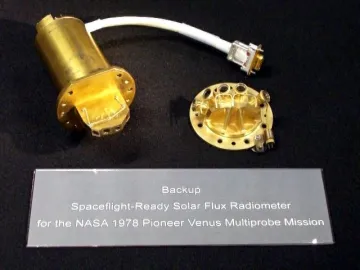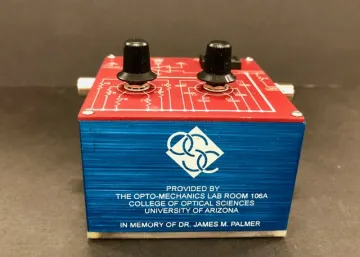Reflections: James M. Palmer

When Research Professor Emeritus James M. Palmer was in the seventh grade, he took a battery of interest and aptitude tests that showed an equal interest and aptitude in both music and science/math. For Jim, whose father was an engineer, it was not too difficult to come to a decision as to what he considered most advantageous … engineering would be his vocation and music would be his avocation. After all, as Jim liked to say, “second-rate engineers still earn enough to eat.”
Achieving much more than second-rate engineer status, Jim was a respected expert in radiometry and infrared systems. He was involved in many aspects of radiometric instrumentation and detector design and fabrication, radiometric measurements and calibration, and systems analysis. Jim also played a vital role in bringing the study of radiometry into the mainstream of optics education and was instrumental in the development of the undergraduate optical engineering program at the University of Arizona.
As for his hobby … Jim was a talented and avid singer. He traveled with choral groups to nine states and 13 foreign countries, performing at Carnegie Hall and before Pope John Paul II in the Sistine Chapel.
Early Life
Jim was born near Midland, Michigan, on Sept. 3, 1937, where he lived with his parents, James and Candace, and his younger sister, Anne, until 1944 when the family moved to Western Springs, Illinois. Jim developed an interest in music at an early age, starting informal piano lessons with his mother at the age of three and formal lessons at the age of six. Later, Jim switched to playing the trumpet so he could play in his school’s marching band, but discovered quickly “that it was impossible to make good music while marching through mud, slush and snow with a mouthpiece frozen to your lips!”
When it came time for Jim to choose a college, he began looking at schools with large science or engineering programs. However, Jim accepted admission to a small liberal arts school, Grinnell College in Iowa, known for its rigorous academics and a tradition of social responsibility, at the suggestion of his father who wanted him to have a broad academic experience. Along with studying physics, Jim found his instrumental music niche in jazz--he played the trumpet throughout his four undergraduate years. He had the memorable experience of playing for two years in a big band organized and directed by fellow classmate and rhythmic pianist, Herbie Hancock. Jim’s passion for choral music also began at Grinnell, as a member of the Glee club.
During Jim’s breaks from school, he would work at his father’s plastics extrusion company, Pyramid-Plastics. He spent one summer helping make some of the first hula-hoops. These early models were held together with a wooden dowel plug placed inside the ends of the plastic tubing. Jim’s job was to staple the plastic ends to the wooden dowel. Today, there are obviously more elegant ways of connecting two ends of plastic tubing. However, lacking these solutions in the 1950s did not stop Jim and his father from getting the job done.
Early Career
In 1959, after graduating with a Bachelor of Arts in Physics, Jim accepted a position as an engineer in Hoffman Electronics Corporation’s Semiconductor Division located in El Monte, California, about 15 miles east of Los Angeles. At that time, you could drive Route 66 from end to end uninterrupted, so Jim packed his car, left Chicago and headed west. 2,448 miles later, after driving through Missouri, Kansas, Oklahoma, Texas, New Mexico, Arizona, and California, Jim arrived in Los Angeles. This experience made a lasting impression on Jim who, for the remainder of his life, avoided interstate highways as much as possible--preferring to drive along two-lane roads, meandering through rural America.

In the late 1950s, Hoffman was making great strides in improving the efficiency and practicality of the first solar cells as a useful source of renewable energy. One of Hoffman’s great achievements was when the first satellite to be powered by their solar cells, the Vanguard I, launched in 1958. It became Jim’s task to calibrate these space-qualified solar cells. True to Jim’s nature, he tackled his first job with precision and attention to detail--both critical in the exacting world of radiometric measurements. Explorer 6, a satellite launched in August 1959, used 9,600 Hoffman photovoltaic cells in its solar arrays.
Graduate School
Motivated by his new-found interest in optics and the relatively new optics program at the University of Arizona, Jim came to Tucson in 1970 for graduate school at the Optical Sciences Center (OSC). Professor Emeritus Bill Wolfe, who was Jim’s Ph.D. adviser, described Jim’s research and final exam.
His dissertation was on the Venus Probe. The problem was to design an appropriate radiometer that would measure the greenhouse effect on Venus. The probe was designed to spiral down to the surface slowly on the tether of a parachute. There were five channels of slightly different spectral sensitivity that would map out the radiation, all in the visible or near infrared. The challenge was the environment. The surface of Venus is about 740K (467 degrees Celsius) and the atmosphere is mostly carbon dioxide with clouds of sulfuric acid.
Jim’s solution was to use windows and lenses of sapphire with rods of the same material that guided the light to five different detectors. They were kept cool enough by a phase change material in close thermal contact with them. It absorbed the heat and gradually melted without increasing the temperature.
During Jim’s final dissertation exam, Marty Tomasko, the Principal Investigator with the Lunar and Planetary Lab, asked Jim a bunch of questions about another, future possible experiment. Then and there, Jim described the proposal for the next project. Needless to say, he passed.
For more information on Jim’s design of the Solar Flux Radiometer (LSFR), one of the instruments carried onboard the Pioneer 13 Mission to Venus, take a look at the poster, Pioneer Venus Solar Flux Radiometer, designed by former OSC Director of Communications, Cathy Alexander.
Teaching
After receiving his Ph.D. in 1975, Jim had to make the decision as to whether to return to industry or stay at OSC. Jim chose to stay at the Center, rising through the academic ranks to a research professorship. For almost 30 years, before retiring in 2004 to become Research Professor Emeritus, Jim took a pioneering approach in both his research and teaching. He made substantial contributions to education in the areas of radiometry and the undergraduate program in optics.

For years, the subject of radiometry, the measurement of optical radiation, had been taught at OSC as a lecture course. In Jim’s opinion, “any course involving measurement should offer hands-on experience in the form of an associated laboratory.” Not deterred by space, time and financial constraints that prohibited the center from offering a formal laboratory course, Jim developed a set of take-home experiments for a course he taught entitled Radiometry, Sources and Detectors (now OPTI 406/506). The students were furnished with a small, inexpensive radiometer and a kit of accessories which allowed a wide variety of self-conducted experiments to be performed. He also developed a laboratory manual to guide the student through the 11 experiments.
“The entire kit and caboodle is housed in an attractive green military surplus ammunition canister that is both rugged and watertight; the student who possesses one of these presents a unique and distinctive appearance on campus.” (J.M. Palmer, “Take-home Laboratory for a Course in Radiometry,” Proc. SPIE 2525, 278 (1995).
In 2012, professors Harry Barrett and Matt Dubin were teaching the radiometry class Jim had previously taught. Professor Jim Burge suggested to them they should reintroduce the take-home lab kits. After they redesigned the kits (minus the ammunition canister) and revamped the lab assignments, it was decided that the kit would not be complete without a nod to Jim Palmer's original efforts. They dedicated the amplifier they had made “In Memory of Dr. James M. Palmer.”
Legacy
Jim’s professional and personal achievements won respect from all who knew him, but it was his commitment to the next generation of optics students that cemented his legacy as a stellar educator. “He loved working with students and he was deeply involved in getting more young people into optics,” recalled Professor Emeritus and Founding Dean, James C. Wyant. In 2006 Jim received the SPIE Educator Award “for his substantial and sustained contributions to education in the critical area of radiometry.”
Editor’s Note: After Jim’s death in 2007, his family, friends, associates and former students contributed generously to a scholarship in his honor. The Palmer Scholarship is available to third- through fifth-year undergraduate students with a demonstrated aptitude for optical engineering.
